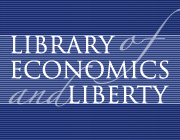
Tjalling Charles Koopmans |

Koopmans was also like Kantorovich in generalizing his approach from one sector of the economy to the economy as a whole. Koopmans showed the conditions required for economy-wide efficiency in allocating resources. He also, again like Kantorovich, used his activity-analysis techniques to derive efficient criteria for allocating between the present and the future.
Koopmans was an economist with the Cowles Commission at the University of Chicago between 1944 and 1955, and then moved with the Cowles Commission to Yale University, where he became professor of economics until he retired in 1981. Koopmans became an American citizen in 1946. He served as president of the American Economic Association in 1981.
"Exchange Ratios between Cargoes on Various Routes (Non-Refrigerating Dry Cargoes)." Memorandum for the Combined Shipping Adustment Board. 1942. Reprinted in Koopmans. Scientific Papers. 1970.
"Optimum Utilization of the Transportation System." Proceedings of the International Statistical Conferences, vol. 5 (1947): 136-45. Reprinted in Supplement to Econometrica 17 (July 1949): 136-46.
Scientific Papers of Tjalling C. Koopmans. 1970. (Contains a bibliography through September 1969.)
Three Essays on the State of Economic Science. 1957.
